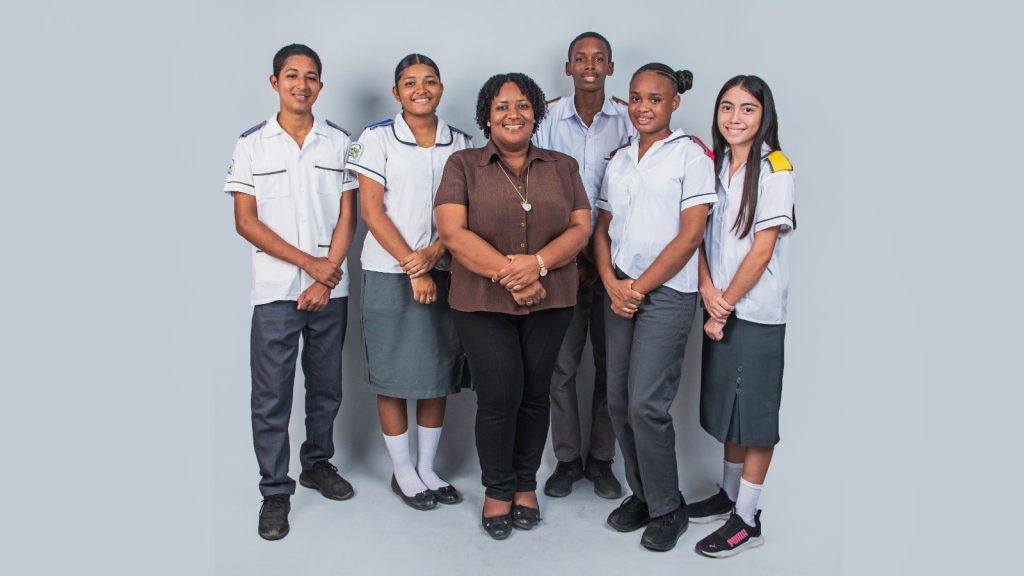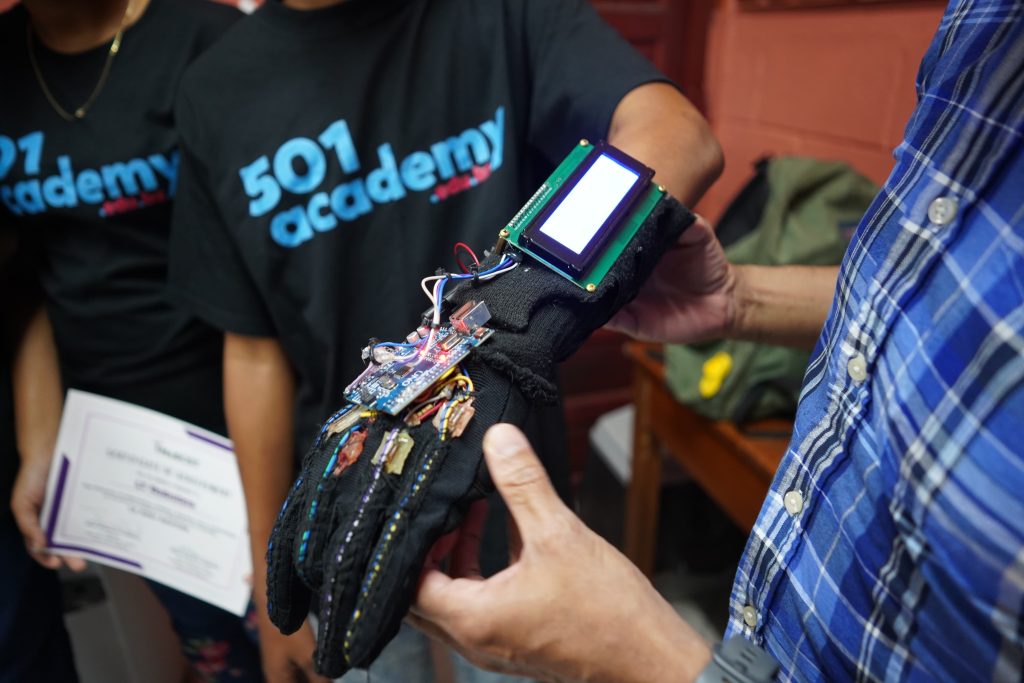Have you ever seen someone close to you struggling from a health condition and wanted to create a magic formula to solve the problem? When an educator and a group of students from Belize connected with each other sharing their experiences with stroke patients, they could not make magic, but they found a way to facilitate their lives. The “AODI” (Assistance Oral Device Interface) project developed a device that can translate hand signals and movements into words, improving communication between patient and caretakers.
The inclusive innovation used STEM (Science, Technology, Engineering and Mathematics) for accessibility and was a finalist in 2024 of Solve for Tomorrow – Central America and Caribbean region, which gathers together 11 countries: Barbados, Belize, Costa Rica, Dominican Republic, Ecuador, El Salvador, Guatemala, Honduras, Nicaragua, Panama and Venezuela.
Five students between 14 and 17 years old participated, from 10th to 12th grade, the last three years of compulsory schooling. The mediator teacher was Ardeth Rudon, who is also the Vice-Principal of Academic Affairs and has been at Ladyville Technical High School for 24 years. It was her first participation at Solve for Tomorrow. The project started with teacher Abraham Flowers, winner of Solve for Tomorrow in 2023, with the project “SMARTZ“, but he was transferred to another school in the middle of the school year. He was also the founder of the LT Robotics Club, where about 20 students have the opportunity to explore their interests in technology.
The Ladyville Technical High School, where the project was born, is located in a rural area, just outside the main city of the country (Belize City). The school works as a hub for the community and, therefore, intends to help people solve social challenges through the Education, especially at the LT Robotics Club, where “AODI” started. “We did brainstorming, discussing issues that community members face and one of such problems was the health issues. We asked ourselves: how can we have a different approach to it?”, remembers Rudon. Then, one of the teenagers, Adobi Thomas, talked about her aunt, who suffered from a stroke, and Rudon’s husband had also suffered from it. “It was a subject so close to us. We delve into the perspective, decided to do something to help and continued our researching”, narrates the teacher.

The group found out that stroke is one of the main causes of death in Belize. With the data, the personal experience and the broader perspective that impacts the community and the country, they decided to focus on this topic. Then, they discovered that many patients develop difficulties in speaking and not being able to communicate makes them feel frustrated. The information collected matched with what their heard family members were experiencing. “When you live with someone that suffered a stroke, you also feel frustrated and helpless for not being able to communicate. We decided to create something to help”, says the teacher.
In addition, the educator explains that when people have a stroke for the first time, their tongues get heavy and they can have speech disorders, possibly provoking muteness. The first 72 hours after a health episode like that is critical because they can suffer another stroke and the lack of communication can make it even harder to identify signs and prevent any more injuries. “What if we could have this device that you could communicate with just the click of a finger?”, the team started to ask themselves.
They made a list of materials needed: wires to connect the system, flex sensors, regulator buttons, something to stabilize the invention and an Arduino board, an open-source electronic prototyping board.
Doing STEM projects like this teaches the students to come up with solutions to the difficulties of their lives, so they won’t be stuck in the future. If we find ways to solve problems, we will make the world a better place, declares the educator.
To use the prototype, the patient put the glove in the hand and would only need to move the fingers to transmit messages through sensors. The algorithms used in the project would translate the signs to words shown on a LCD screen (a display technology that uses liquid crystals and light polarizers to form images). It can decode words and expressions up to 14 characters, such as “good morning”, “yes”, “no” and “I need my meds [medications]”. To give more comfort, they also put velcro and a regulator so that the patient can adapt the glove to its hand.
The team had to train the machine with programming to set some finger movements and their respective meanings. But what makes AODI even more of an inclusive innovation it’s the customization that suits the individual’s needs. The patient might be not speaking at all, while others may get to say some words but need another set of expressions. For instance, the movement of the thumb means “I need medication” for one person, it could be reset to mean “I want water”.
Another advantage is that this prototype can get ten times cheaper than those from the market: while it might cost up to 500 american dollars for a device like that, with customization AODI can cost up to 50 dollars.

Overcoming challenges to make an inclusive innovation
During the project, the group faced multiple challenges. Some wires burned because they were using too much voltage and had to switch for new ones and learn how to regulate it properly. Besides that, some days before they traveled to Finals of Solve for Tomorrow, in Guatemala, almost the entire team got sick. “I saw them studying even in the hospital, they didn’t want to give up on the final moment”, Rudon recalls. “We had hard times, but rather than getting frustrated, we laughed, took a timeout, ate something and went back to work”, adds.
Even with the difficulties, they tried their best. To test AODI, one of the students even tried with his aunt who suffered from a stroke. She was excited to know something new that could make a difference in her communication with family. They tested between themselves and with some teachers, but did not have the time to test it with more patients, which is something they’d like to do in the future.
Rudon also sees many other possibilities to improve AODI, such as expanding the amount of phrases and words and customizing the device in different colors and materials, and making it waterproof. The group wants to add Bluetooth capabilities and an audio version of the messages that already appear on the LCD screen in text format.
The educator recognizes that the community played an important role as well. She recalls that when parents found out that the school was representing this entire country in Solve for Tomorrow, they were excited and engaged with the process. “They came out to support, offered to help with transportation. They were making sure kids participated even when we had floods. They always figured out a way to get them there”, adds.
With the success of AODI, the Ministry of Education of Belize is now excited to invest in the idea and has already contributed financially so the group would make 10 more prototypes to be replicated in other communities. “This is really important for the school as well. It puts us in a spotlight for future projects. Put us on the map”, finishes.




